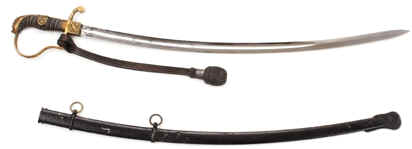
 |
|
|
#8 |
|
Member
Join Date: Mar 2006
Location: Room 101, Glos. UK
Posts: 4,259
|
i see this on a few similar sabre hilts, noteably the one on this illustration appears to have that feature.
 and this one:  just a reasoned guess: the 90 degree corner there is a weak point & in a casting especially would require a radiused section on the inside as re-enforcement. the decorative lines may be just that, or as this area is also used to attach the sword knots (used as a lanyard to keep you from accidentally dropping your sword while on horseback, which could prove embarrassing in a battle) it could serve as a restraining device to keep the knot in place. many hilts of course have a slot near the pommel for this (like the heavy cav. sabre in the photo).  
Last edited by kronckew; 27th June 2007 at 03:04 PM. |
|
|

|
|
|